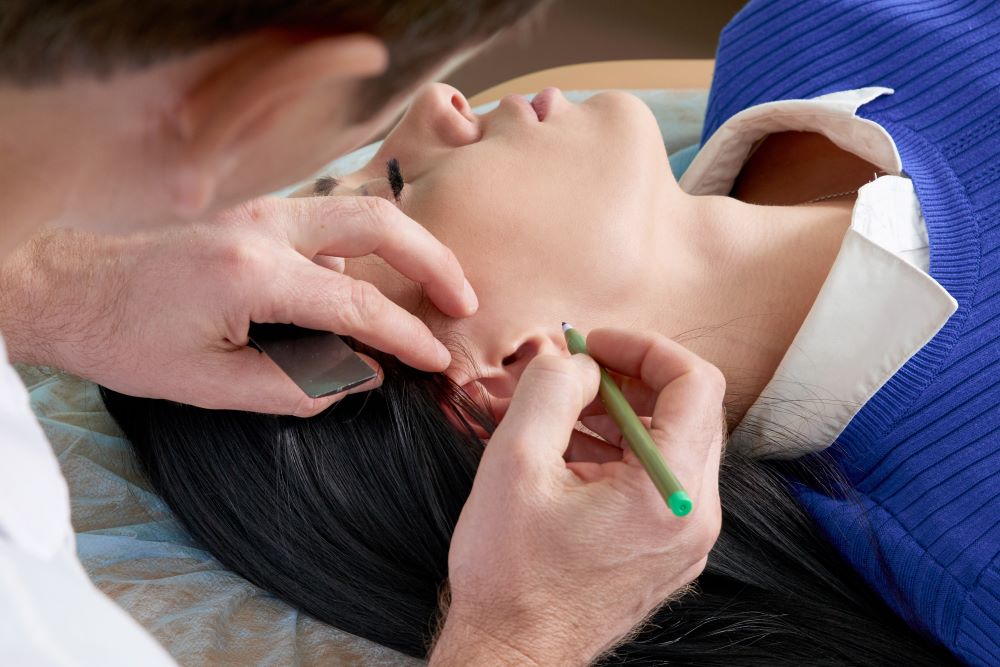This procedure may be necessary if the eardrum has been damaged due to infection, trauma, or other factors.
Myringotomy (Ear Tube Placement): Myringotomy is a minimally invasive procedure in which a small incision is made in the eardrum to drain fluid from the middle ear. Ear tubes (tympanostomy tubes) are often inserted to prevent fluid buildup and improve hearing in cases of chronic ear infections or otitis media.

Common Types of Ear Surgery
Auricular (Ear) Reconstruction Surgery: This type of surgery is performed for cosmetic purposes to reshape or reconstruct the external ear, typically in cases of congenital ear deformities (e.g., microtia) or traumatic ear injuries.
Earlobe Repair Surgery: Earlobe repair surgery is a cosmetic procedure done to repair torn or stretched earlobes, often due to wearing heavy earrings or accidents.
Cochlear Implant Surgery: Cochlear implant surgery is a procedure used to implant a device that directly stimulates the cochlea in the inner ear to provide hearing for individuals with severe or profound hearing loss who do not benefit from hearing aids.
Audioplasty (Ear Pinning Surgery): Auriculoplasty, also known as otoplasty, is a cosmetic procedure to reshape or reposition protruding or misshapen ears, often for aesthetic reasons.
Ear Tumor or Cyst Removal: Surgical procedures may be performed to remove tumors, cysts, or other growths in or around the ear.
Ear Canal Reconstruction: In cases of congenital or acquired deformities of the ear canal, surgical reconstruction may be necessary to restore its shape and function.
common symptoms
Ear Fullness or Pressure: Some patients may experience a sensation of fullness or pressure in the ear, which can be due to swelling or changes in the ear canal. This typically resolves over time.
Itching or Numbness: Itching around the ear or numbness in the surgical area may occur during the healing process.
Tinnitus (Ringing in the Ear): Tinnitus, or ringing in the ear, may persist or even temporarily worsen after ear surgery. This is often related to the healing process and typically improves over time.
Scabbing or Crusting: Scabs or crusts may form around the surgical site as it heals. It’s important not to pick at or remove these crusts to avoid infection or complications.
Infection: Although rare, infection is a possible complication of ear surgery. Signs of infection may include increased pain, redness, warmth, and discharge from the surgical site. Prompt medical attention is essential if infection is suspected.
Hearing Aid Adjustment: Patients who use hearing aids may need adjustments or modifications to their devices after ear surgery to accommodate changes in their ear anatomy.
Ear Surgery Procedure
Tympanoplasty (Eardrum Repair Surgery):
- Tympanoplasty is performed to repair a perforated or damaged eardrum.
- The surgeon typically makes an incision behind or inside the ear to access the middle ear.
- The damaged eardrum is repaired using a graft, often taken from the patient’s own tissues or a synthetic material.
- The graft is placed over the hole or perforation in the eardrum and secured in position.
- The procedure aims to restore hearing and prevent recurrent ear infections.
Myringotomy (Ear Tube Surgery):
- Myringotomy is commonly performed on children to treat recurrent ear infections and fluid buildup in the middle ear.
- A small incision is made in the eardrum to create an opening.
- A tiny tube (ear tube or tympanostomy tube) is inserted through the incision into the middle ear.
- The tube helps equalize pressure and drain fluids, reducing the risk of ear infections and improving hearing.
Ossiculoplasty:
- Ossiculoplasty is performed to repair or reconstruct the small bones (ossicles) in the middle ear, such as the stapes, malleus, and incus.
- The procedure is done to treat conductive hearing loss caused by damage to these bones.
- The surgeon may replace damaged or missing ossicles with prosthetic devices to restore proper hearing function.
Mastoidectomy:
- Mastoidectomy involves the removal of infected or damaged tissue within the mastoid bone, which is located behind the ear.
- The procedure is typically used to treat chronic ear infections or complications arising from middle ear infections.
- The surgeon may access the mastoid bone through an incision behind the ear.
Stapedectomy:
- Stapedectomy is performed to treat otosclerosis, a condition in which the stapes bone in the middle ear becomes fixed and unable to vibrate properly.
- The surgeon removes the stapes bone and replaces it with a prosthesis, such as a piston or wire, to restore hearing.
Precautions
Protect the Ear: If instructed by your surgeon, use protective dressings, earplugs, or other devices to shield the surgical site from potential harm.
Medication Management: Take prescribed medications as directed, including pain relievers and antibiotics if prescribed. Do not stop taking medications without consulting your healthcare provider.
Avoid Smoking and Alcohol: Smoking and alcohol can interfere with the healing process. It’s advisable to refrain from these activities during your recovery.
Healthy Diet: Maintain a balanced diet to support healing. Ensure you stay hydrated and consume foods rich in vitamins and nutrients.
Recovery
Follow-Up Appointments: Attend all scheduled follow-up appointments with your surgeon. These appointments are crucial for monitoring your progress and addressing any concerns.
Returning to Activities: Gradually resume normal activities as advised by your surgeon. Avoid activities that could put stress on the surgical area until cleared by your healthcare provider.
Avoid Flying: Depending on the surgery and your surgeon’s recommendations, it may be advisable to avoid air travel for a certain period.
Monitor for Infection: Keep an eye on the surgical site for signs of infection, such as increased pain, redness, swelling, or discharge. Contact your surgeon if you suspect an infection.
Patience: Be patient with the recovery process. Healing times can vary, and it may take weeks to months to experience the full benefits of the surgery.
